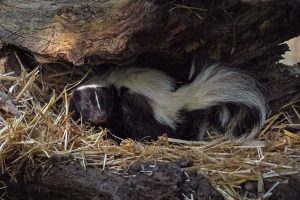Memorable and rightly feared for that particular, pungent odor (which humans can detect 3.5 miles downwind!), skunks are recognizable by their black and white fur. Some boast, instead, a brown or gray or cream-colored coat, but all are similar enough to curl the end of your hair if you meet one unexpectedly on an evening stroll.
Their omnivorous diet of insects and some lesser pests may make them valuable to your area. Unfortunately, the skunk is one of four wild animals known to be a primary carrier of the rabies virus (others being: bats, raccoons, and foxes), so a sizeable distance is desired.
While that infamous scent can stick to a person, clothing, a dog, or a car, the silver lining is that a skunk utilizes it only when they —or their kits, as the babies are called— are threatened. This means that as soon as you spot one of these striped rascals, the safest exit is a slow and quiet one.
Not one to blindside their victim before causing discomfort, skunks will often warn before they spray. They stamp their feet, hiss, make short forward charges, and the spotted skunk goes up into a handstand. Despite very poor eyesight, capping out at about 3 meters, their aim with their spraying-glands is precise, also with a 3-meter range.
A skunk in the neighborhood is likely to be smelled before being seen. Skunks do leave signs, of course, such as dug up shallow holes to forage grubs, turned over garbage cans, mysteriously missing pet food, and damage to the lower leaves of garden crops as they grab any low-hanging fruit.
To deter these rascals, properly seal garbage cans (metal cans with lids that snap into place are best), clean up any picnic scraps, and fill or seal holes in the yard, especially under elevated sheds, slabs under porches, and crawl spaces. If the discouraging tactics don’t work, it is time to call in a professional pest removal company for assistance.
Removing Skunk Odor:
Skunk odor is an oil-based pheromone mixed with sulfur-based chemicals produced from the musk glands on either side of the skunk’s anus. Once this oil-based liquid gets on a surface, it is very difficult to remove; some attempts may actually spread the oils around if done improperly. Below is our dependable solution, comprised of common household products, that we recommend in treating sprayed pets.
- 1 liter (or quart) of white vinegar or 3% hydrogen peroxide (peroxide may cause bleaching)
- 1/4 cup of baking soda
- 1 tsp. dish detergent (this is a degreaser and will help break down the oils)
This solution can be used on fabrics or animals. Use straight bleach to remove smells on outdoor structures, such as foundations, decks, or ground.
__________________________________________________________
Creature Control is a family and veteran-owned, locally operated pest and animal management company servicing several counties throughout lower Michigan. Our technicians are licensed, certified, and experienced in providing effective pest control, preventative maintenance, cleanup, and repairs. We offer you peace of mind as your all-inclusive wildlife and insect remediation specialists. Call us at 800-441-1519 or send us a message today.
Written by the digital marketing staff at Creative Programs & Systems: www.cpsmi.com.
